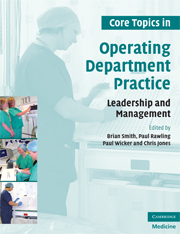Book contents
- Frontmatter
- Contents
- List of contributors
- Foreword
- Preface
- 1 Managing change in perioperative education
- 2 The role of the operating department manager within the context of the organization
- 3 Action learning: a new way of problem solving in perioperative settings
- 4 Agenda for change: what do theatre staff need to know?
- 5 The SWOT analysis: its place in strategic planning in a modern operating department
- 6 Corporate governance: setting the scene for perioperative practice
- 7 Managing different cultures: adversity and diversity in the perioperative environment
- 8 Leadership in perioperative settings: a practical guide
- 9 Management and leadership of advanced practice
- 10 Managing conflict in perioperative settings
- 11 The management and organization of emergency operating lists
- 12 Organizational culture
- 13 Development matters in the NHS; including a perioperative approach to the KSF
- 14 Equipment procurement: a purchaser's guide for theatre managers
- 15 The reflective practitioner in perioperative settings
- 16 New ways of working in perioperative practice
- 17 Damned if you do and damned if you don't: whistle blowing in perioperative practice
- 18 A manager's experience of recruitment and retention
- 19 The management of change
- Index
- References
5 - The SWOT analysis: its place in strategic planning in a modern operating department
- Frontmatter
- Contents
- List of contributors
- Foreword
- Preface
- 1 Managing change in perioperative education
- 2 The role of the operating department manager within the context of the organization
- 3 Action learning: a new way of problem solving in perioperative settings
- 4 Agenda for change: what do theatre staff need to know?
- 5 The SWOT analysis: its place in strategic planning in a modern operating department
- 6 Corporate governance: setting the scene for perioperative practice
- 7 Managing different cultures: adversity and diversity in the perioperative environment
- 8 Leadership in perioperative settings: a practical guide
- 9 Management and leadership of advanced practice
- 10 Managing conflict in perioperative settings
- 11 The management and organization of emergency operating lists
- 12 Organizational culture
- 13 Development matters in the NHS; including a perioperative approach to the KSF
- 14 Equipment procurement: a purchaser's guide for theatre managers
- 15 The reflective practitioner in perioperative settings
- 16 New ways of working in perioperative practice
- 17 Damned if you do and damned if you don't: whistle blowing in perioperative practice
- 18 A manager's experience of recruitment and retention
- 19 The management of change
- Index
- References
Summary
Key Learning Points
Develop an understanding of the SWOT (strengths/weaknesses/opportunities/threats) analysis
Discuss how SWOT can improve on perioperative service delivery
Develop skills in objectively analysing the clinical environment
Introduction
Since the UK Government White Paper (Griffiths, 1984) on reforming the NHS and the introduction of NHS Trust hospital status; the NHS has become a business driven by productivity and income generation. Services beyond the operating department have also been affected; in particular general practitioners (GPs) face a more challenging workload of treating patients and managing busy practices. Like GPs, hospital managers have also been charged with the responsibility and accountability of managing financial budgets for their department/services. While these changes to health policies strengthen the management of patient services and managerial autonomy, they do not come free from tensions among health care staff. Change management in the NHS since the late 1970s has become a key aspect of a manager's role. It has been argued the NHS is in a constant state of ‘flux’ and changes to staff roles are viewed as a threat, leading to resistance to change and dissatisfaction.
Any business wishing to succeed in a constant changing world needs to be ready and agile enough to respond to new demands. This perhaps is what the NHS has achieved since the mid 1970s in response to new health demographics.
Many practitioners will have been involved in past changes and probably recognize the terms ‘just-in-time’ management, ‘quality circles’ and so on. While personal experiences of those management techniques may be mixed, adopting and evaluating their application can help managers to cope with, and maximize their responses to, strategic change. In this chapter, the term strategic change is used to denote change that has an impact on the whole department, for example implementing a new infection control policy or practice.
- Type
- Chapter
- Information
- Core Topics in Operating Department PracticeLeadership and Management, pp. 34 - 38Publisher: Cambridge University PressPrint publication year: 2009

